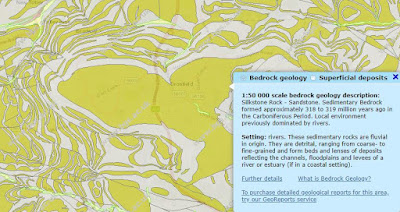 |
| Memorial stones at the old Dronfield Methodist Church |
At the beginning of 2019, I spent my first few days out preparing the February field trip with the Sheffield U3A Geology Group to investigate The Building Stones of Leeds and, having finished this in plenty of time, I began to plan for the rest of the year – to continue my investigation of the geology and mediaeval churches in and around South Yorkshire by public transport.
 |
| A geological map of the area around Dronfield |
Having already explored Norton on the edge of Sheffield a few times, it was just a natural progression to take the bus a little further south to visit the town of Dronfield, which lies on a syncline that is formed within an extensive outcrop of the Silkstone Rock.
 |
| Dronfield Baptist Church |
Alighting from the bus at the edge of the old centre of Dronfield, a walk along High Street downhill to the church takes you past numerous historic stone buildings – the oldest dated at 1596 – that are constructed from what is presumably locally quarried Silkstone Rock.
 |
| Dronfield public library |
The former Manor House C1700, now a public library, is constructed in a light brown/buff coloured sandstone that is of a uniform tone where large blocks are used in the quoins and dressings; however, the smaller blocks used for the ashlar walling, which are presumably taken from less massive beds, have a greater yellow/orange and occasionally dark brown colour variation.
 |
| 22-26 High Street |
A little further down High Street, on the opposite side of the road, a terrace of mid 19th century houses have a slightly different character. Here, where the dark patina typical of Carboniferous sandstones has been weathered away, an orange colouration is dominant.
 |
| The Peel Monument |
The Peel Monument, erected in 1846 to commemorate the repeal of the Corn Laws, is obviously completely different and, at a distance, looks like it could be made of grey granite from Devon or Cornwall - which is common in Victorian monuments. A close inspection, nevertheless, reveals that it is in fact a very coarse Millstone Grit with frequent fingernail sized pebbles.
 |
| The former Dronfield Methodist Church |
The former Dronfield Methodist Church, dated 1863, is also built with sandstone that contains distinct yellow/orange colouration, and several memorial stones that have been included at the base of its west elevation are distinctly reddened.
 |
| The Hall and the Blue Stoops Inn |
The Hall, of the early C18, and the Blue Stoops Inn opposite, dated 1594, are built with sandstone that has similar physical characteristics to the buildings previously noted and this pattern continues in the historic buildings that line High Street. This includes the refurbished and apparently cleaned Dronfield Hall Barn, which is set back some distance from the road.
 |
| Historic buildings on High Street |
At the bottom of High Street, the doorway of the old town hall provides another example of reddened sandstone and turning the corner into Church Street, which winds down the hill towards the River Drone, the early Georgian Old Vicarage and the adjacent Red House are particularly notable for being constructed in red brick.
 |
| The Old Vicarage and the Red House |
No comments:
Post a Comment